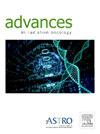In Silico Assessment of the Radiation Dose Range for Definitive Stereotactic Body Radiation Therapy of Primary Breast Cancer
IF 2.7
Q3 ONCOLOGY
引用次数: 0
Abstract
Purpose
The maximal dose for partial breast irradiation (PBI) with stereotactic body radiation therapy for definitive local therapy of nonmetastatic breast cancer has not been established. Here we evaluate the maximal achievable coverage of the planning target volume suitable for PBI without violating organs-at-risk constraints.
Methods and Materials
Planning computed tomography scans of 22 patients with pulmonary or cardiac risk factors and left-sided disease in prone and supine position (sp) were obtained. Plans for PBI in 5 fractions were generated according to the Guidelines of the American Society for Radiation Oncology. Maximum tolerated dose (MTD) was defined when the dose reached any constraint of a neighboring organ based on recommendations of the American Association for Physics in Medicine.
Results
Mean MTD was 45.9 ± 3.9 Gy (range, 38.8-53.9) in sp and 46.1 ±3.2 Gy (range, 37.3-53.9) in prone position (pp), respectively. The MTD was ≥44.3 Gy in sp and ≥44.8 Gy in pp in 95% of patients. Fat tissue was the dose limiting structure in 11 of 22 patients in sp and 15 of 22 in pp. Dmax to the fat tissue reached 40.0 Gy (±3.3 Gy) in sp and pp. Skin was the dose limiting structure in 7 of 22 patients in sp and in 6 of 22 in pp. Dmax to the skin was 30.5 Gy (±7.4 Gy) in sp and 31.0 Gy (±7.0 Gy) in pp (P = .8). Ribs were dose limiting in 4 of 22 patients in sp and in 1 of 22 in pp. Dmax to the ribs was 31.4 Gy (±9.5 Gy) in sp and 21.4 Gy (±11.0 Gy) in pp (P < .01). Dmax to the intraventricular artery was 3.4 Gy (±3.1 Gy) in sp and 7.5 Gy (±5.7 Gy) in pp (P < .01).
Conclusions
For definitive stereotactic body radiation therapy for early-stage breast cancer, we propose a dose escalation starting with 45 Gy in 5 fractions to be tested in a clinical trial. Prone position is advised for tumors close to the thoracic cage.
原发性乳腺癌立体定向放射治疗放射剂量范围的计算机评价
目的立体定向体放射治疗部分乳房照射(PBI)对非转移性乳腺癌局部治疗的最大剂量尚未确定。在此,我们评估了在不违反危险器官约束的情况下,适合PBI的规划目标体积的最大可实现覆盖率。方法与材料对22例有肺部或心脏危险因素及左侧疾病的患者进行俯卧位和仰卧位(sp)计算机断层扫描。根据美国放射肿瘤学协会的指南,制定了5个部分的PBI计划。最大耐受剂量(MTD)的定义是根据美国医学物理协会的建议,当剂量达到邻近器官的任何限制时。结果俯卧位平均MTD为45.9±3.9 Gy(38.8 ~ 53.9),俯卧位平均MTD为46.1±3.2 Gy(37.3 ~ 53.9)。95%的患者sp的MTD≥44.3 Gy, pp≥44.8 Gy。sp组22例中有11例,pp组22例中有15例以脂肪组织为限剂量结构,sp组和pp组22例中有7例以皮肤为限剂量结构,sp组22例中有7例以皮肤为限剂量结构,pp组22例中有6例以皮肤为限剂量结构,sp组皮肤为30.5 Gy(±7.4 Gy), pp组为31.0 Gy(±7.0 Gy) (P = 0.8)。sp组22例患者中有4例肋骨受剂量限制,pp组22例患者中有1例肋骨受剂量限制。sp组肋骨的Dmax为31.4 Gy(±9.5 Gy), pp组为21.4 Gy(±11.0 Gy) (P <;. 01)。sp组Dmax为3.4 Gy(±3.1 Gy), pp组Dmax为7.5 Gy(±5.7 Gy) (P <;. 01)。结论:对于早期乳腺癌的明确立体定向放射治疗,我们建议在临床试验中进行5次剂量递增,从45 Gy开始。靠近胸腔的肿瘤宜俯卧位。
本文章由计算机程序翻译,如有差异,请以英文原文为准。
求助全文
约1分钟内获得全文
求助全文
来源期刊

Advances in Radiation Oncology
Medicine-Radiology, Nuclear Medicine and Imaging
CiteScore
4.60
自引率
4.30%
发文量
208
审稿时长
98 days
期刊介绍:
The purpose of Advances is to provide information for clinicians who use radiation therapy by publishing: Clinical trial reports and reanalyses. Basic science original reports. Manuscripts examining health services research, comparative and cost effectiveness research, and systematic reviews. Case reports documenting unusual problems and solutions. High quality multi and single institutional series, as well as other novel retrospective hypothesis generating series. Timely critical reviews on important topics in radiation oncology, such as side effects. Articles reporting the natural history of disease and patterns of failure, particularly as they relate to treatment volume delineation. Articles on safety and quality in radiation therapy. Essays on clinical experience. Articles on practice transformation in radiation oncology, in particular: Aspects of health policy that may impact the future practice of radiation oncology. How information technology, such as data analytics and systems innovations, will change radiation oncology practice. Articles on imaging as they relate to radiation therapy treatment.
 求助内容:
求助内容: 应助结果提醒方式:
应助结果提醒方式:


